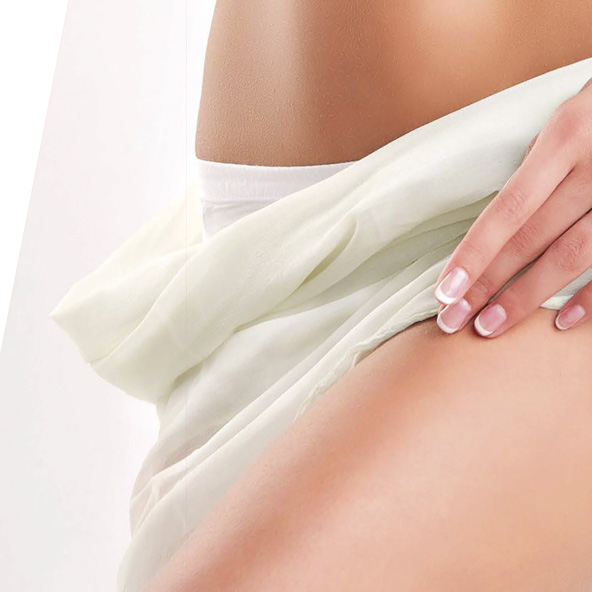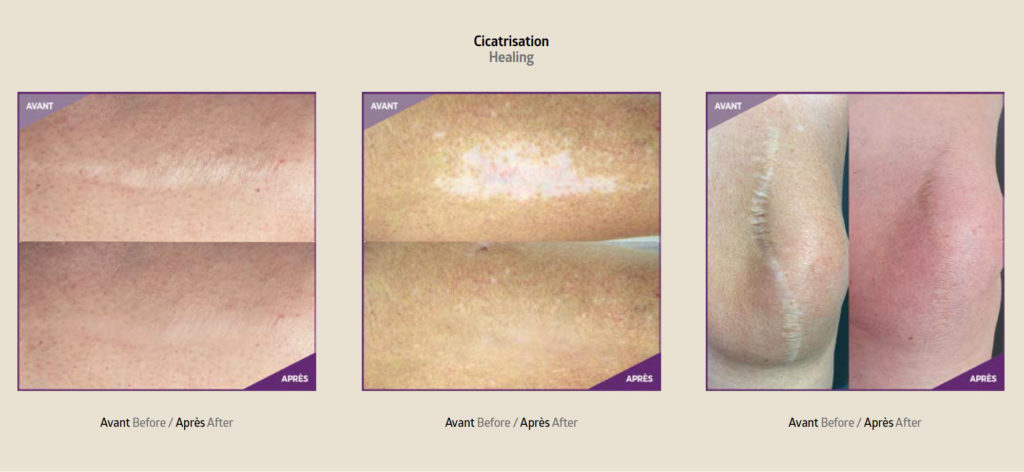By Maud Ravier
The dermo-aesthetice solution for camouflaging scars and forgetting they are even there!
Accidents, burns, surgery… These are just a few of the things that can leave a mark on the skin and affect our self-esteem. Scars, though they are quite common, cause many hang-ups. They never completely disappear and only a few techniques are able to reduce their appearance.
Healing: a long-term process
 Healing is a natural, progressive process that occurs following an accidental or surgical wound and happens over several phases.
Healing is a natural, progressive process that occurs following an accidental or surgical wound and happens over several phases.
It is vital that each phase plays out correctly if we are to achieve a quality scar, which is not only aesthetic but also does not hinder one’s movements. But, even if we do everything we can – inclu-ding protecting the scar from the sun and massaging it regularly – it is impossible to predict how it will look in the long term, since the healing process depends on factors as diverse as age, diet, and even its position.
One thing is for certain: a permanent scar takes six months to a year, or even more, to form, and it is only then that we can see what it will look like.
An indelible mark
In the case of superficial wounds where only the epidermis is affected, healing only requires the skin to be repaired and does not leave a mark. But, as soon as the wound touches the epidermis, a scar is inevitable. It is therefore impossible to make it disappear completely, but we can, in some cases, improve its appearance. Different techniques are available to healthcare professionals – lasers, cosmetic surgery, dermabrasion, corticoid injections, continuous compression, etc. – to reduce the scarring, but these techniques themselves can generate new scars.
Life Repair® corrective pigment camouflage
 Another way of reducing a scar is by “camouflaging” it to make it as inconspicuous as possible. Dermo-pigmentation allows us to introduce colour to a depigmented area of skin, such as a white scar, or to lighten a dark scar for a discreet and harmonious appearance thanks to the choice of tone-on-tone pigments.
Another way of reducing a scar is by “camouflaging” it to make it as inconspicuous as possible. Dermo-pigmentation allows us to introduce colour to a depigmented area of skin, such as a white scar, or to lighten a dark scar for a discreet and harmonious appearance thanks to the choice of tone-on-tone pigments.
Beyond camouflaging the scar, the pigmentation treatment, which is carried out using very fine needles, stimulates cell renewal and therefore boosts the skin’s natural healing process.
When and how to act
Though it is suitable for all areas, corrective pigmentation is particularly recommended after cosmetic surgery (breast surgery, lifts, etc.) or reparative surgery (post-mastectomy). Cleft lip scars are also a good indication because pigmentation helps redefine the lip contour. Finally, it can camouflage and relax burn scars, even those that have received skin grafts, or stretch marks, which are another type of indelible skin mark.To properly apply corrective pigmentation to a scar, we first need to wait for the scar to settle and take on its defi nitive appearance, generally 1 to 2 years after the start of the healing process.
Certified CE IIb pigments for optimum safety
When we are working on damaged skin, the choice of pigment used is particularly important. It is better to opt for extremely high quality, organic pigments. Sterilised using gamma rays, these pigments are dermatologically tested, vegan, free from preservatives, and do not contain any toxic pigments, heavy metals or other aromatic amines. Produced thanks to continuous innovations by the leading ma-nufacturer of permanent make-up, LIFE REPAIR® corrective pigment camouflage is today the highest-performance and safest aesthetic solution to hide scars and make them almost invisible!
 Maud Ravier: A graduate of the Élysée Marbeuf school, Maud Ravier specialised in permanent make-up in 2000, a fi eld she quickly revolutionised. Having created exclusive techniques, today she is putting her expertise to use in the field of dermo-aesthetics, both in her beauty salons and her training academies.
Maud Ravier: A graduate of the Élysée Marbeuf school, Maud Ravier specialised in permanent make-up in 2000, a fi eld she quickly revolutionised. Having created exclusive techniques, today she is putting her expertise to use in the field of dermo-aesthetics, both in her beauty salons and her training academies.
More information: maud.fr














